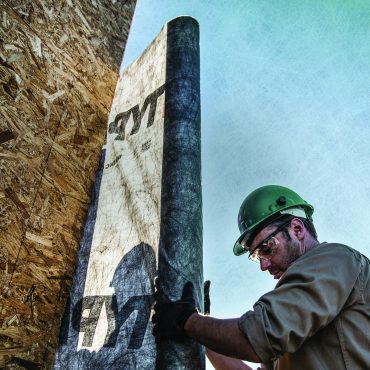
canadiancontractor
Air barriers defined
Choosing an effective air barrier ensures a comfortable and energy efficient home
This is a sponsored post courtesy of Typar
Controlling the movement of air between the conditioned interior environment of a house and the exterior is a core function of building science. According to the U.S. Department of Energy, up to 40 per cent of the energy used to heat and cool a building is due to uncontrolled air leakage. Establishing a continuous air barrier reduces heating and cooling costs, and as a result, lowers greenhouse gas production. Air barriers also play a major role in the overall comfort and indoor air quality of a home.
So, what is an air barrier? Quite simply, it is a material or system of materials designed to serve as the primary air enclosure boundary separating indoor air and outdoor air. Air barrier systems also typically define the pressure boundary of the building enclosure. The requirement for continuous air barriers was added to the International Energy Conservation Code (IECC) with the 2012 version, and there are a number of ways to meet this requirement.
 First, it’s important to understand that an air barrier can be defined as either a material or an assembly, each subject to a specific set of tests. For an individual building material to be classified as an air barrier, its air permeance must be equal to or less than 0.02 L/(s-m2) @ 75 Pa when tested in accordance with ASTM E2178. Keep in mind that air permeance is the amount of air that migrates through materials and not through holes or gaps.
First, it’s important to understand that an air barrier can be defined as either a material or an assembly, each subject to a specific set of tests. For an individual building material to be classified as an air barrier, its air permeance must be equal to or less than 0.02 L/(s-m2) @ 75 Pa when tested in accordance with ASTM E2178. Keep in mind that air permeance is the amount of air that migrates through materials and not through holes or gaps.
The requirements for an air barrier assembly are somewhat less stringent and are measured in terms of air leakage. When tested in accordance with ASTM E2357, the requirement for an air barrier assembly is 0.2 L/(s-m2) in both directions (infiltration/exfiltration)—or ten times greater than a material alone. Air barriers can also be defined through whole building testing in accordance with ASTM E779: Standard Test Method for Determining Air Leakage Rate by Fan Pressurization.
No matter how it is defined, it is important to establish a continuous air barrier for a number of reasons. Air barriers create a much more comfortable environment for homeowners by reducing drafts, keeping conditioned air inside the building, minimizing temperature differences between rooms, and can also improve acoustical isolation. Air barriers play a central role in ensuring healthy indoor air, as well, because they reduce the infiltration of outdoor air pollutants and help control moisture issues that can lead to mold growth.
For more information, visit www.typar.com

Leave a Reply